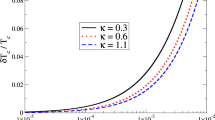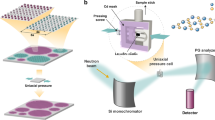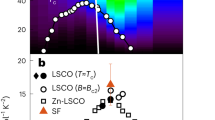Abstract
One of the main challenges to theoretical attempts to understand the microscopic mechanism of high-transition-temperature (high- T c) superconductivity is to account quantitatively for the superconducting condensation energy, the energy by which the normal state differs from the superconducting state1,2,3,4,5,6. A microscopic model commonly used to describe the superconducting copper oxides, the t - J model7, is thought to capture the essential physics of the phenomenon: the interplay between the electrons' kinetic energy and their antiferromagnetic exchange interaction. Within the t - J model the condensation energy can be related to the change in the dynamical spin structure between the superconducting and the normal states8. Here we propose a microscopic mechanism for the condensation energy of high- T c superconductors. Within this mechanism, the appearance of a resonance in the superconducting state9,10,11,12,13 enables the antiferromagnetic exchange energy in this state to be lowered relative to the normal state. We show that the intensity of the resonant neutron-scattering peak observed previously in YBa2Cu3O7 when it undergoes the transition to the superconducting state14,15,16 is in quantitative agreement with the condensation energy of these materials2,3.
This is a preview of subscription content, access via your institution
Access options
Subscribe to this journal
Receive 51 print issues and online access
$199.00 per year
only $3.90 per issue
Buy this article
- Purchase on Springer Link
- Instant access to full article PDF
Prices may be subject to local taxes which are calculated during checkout
Similar content being viewed by others
References
Shrieffer, J. R. Theory of Superconductivity(Addison-Wesley, Reading, MA, 1964).
Loram, J. et al. The electronic specific heat of YBa 2 (Cu 1− x Zn x)3 O 7 from 1.6 to 300 K. Physica C 171, 243–256 (1990).
Loram, J. et al. Electronic specific heat of YBa 2 Cu 3 O 6+ x et al. from 1.8 to 300 K. J. Supercond. 7, 243–249 (1994).
Chester, G. V. Difference between normal and superconducting states of a metal. Phys. Rev. 103, 1693–1699 (1956).
Chakravarty, S. et al. Interlayer tunneling and gap anisotropy in high temperature superconductors. Science 261, 337–340 (1993).
Leggett, A. Where is the energy saved in cuprate superconductivity?Preprint, Univ. Illinois at Urbana-Champaign((1998)).
Zhang, F. C. & Rice, T. M. Effective Hamiltonian for the superconducting copper-oxides. Phys. Rev. B 37, 3759–3763 (1988).
Scalapino, D. J. & White, S. The superconducting condensation energy and an antiferromagnetic exchange based pairing mechanism.Preprint cond-mat/9805075 at 〈http://xxx.lanl.gov〉 ((1998)).
Demler, E. & Zhang, S. C. Theory of resonance neutron scattering of high T csuperconductors. Phys. Rev. Lett. 76, 4126–4129 (1995).
Meixner, S. et al. Finite size studies on the SO (5) symmetry of Hubbard model. Phys. Rev. Lett. 79, 4902–4905 (1997).
Eder, R., Hanke, W. & Zhang, S. C. Numerical evidence for SO (5) symmetry and superspin multiplets in the two dimensional t - J model. Phys. Rev. B 57, 13781–13789 (1998).
Demler, E., Kohno, H. & Zhang, S. C. πexcitation of the t - J model. Phys. Rev. B 58, 5719–5730 ((1998)).
Zhang, S. C. Aunified theory based on SO (5) symmetry of superconductivity and antiferro-magnetism. Science 275, 1089–1096 (1997).
Mook, H. et al. Polarized neutron determination of the magnetic excitation in YBa 2 Cu 3 O 7. Phys. Rev. Lett. 70, 3490–3493 (1993).
Fong, H. F. et al. Phonon and magnetic neutron scattering at 41 meV in YBa 2 Cu 3 O 7. Phys. Rev. Lett. 75, 316–319 (1995).
Fong, H. F. et al. Polarized and unpolarized neutron scattering study of the dynamic spin susceptibility in Yba 2 Cu 3 O 7. Phys. Rev. B 54, 6708–6720 (1996).
Shastry, S. & Sutherland, B. Twisted boundary conditions and effective mass in Heisenberg-Ising and Hubbard rings. Phys. Rev. Lett. 65, 243–246 (1990).
Scalapino, D., White, S. & Zhang, S. C. Superfluid density and the Drude weight of the Hubbard model. Phys. Rev. Lett. 68, 2830–2833 (1992).
Chakravarty, S. Do electrons change their c-axis kinetic energy upon entering the superconducting state?Preprint cond-mat/9801025 at 〈http://xxx.lanl.gov〉 ((1998)).
Timusk, T. & Statt, B. The pseudogap in high temperature superconductors: an experimental survey. Rep. Prog. Phys.(in the press).
Reznik, D. et al. Direct observation of optical magnons in YBa 2 Cu 3 O 6.2. Phys. Rev. B 53, R14741–R14744 (1996).
Hayden, S. et al. High frequency spin waves in YBa 2 Cu 3 O 6.15. Phys. Rev. B 54, R6905–R6908 (1996).
Scalapino, D. The case for d x 2 − y 2 pairing in the cuprate superconductors. Phys. Rep. 250, 329–365 (1995).
Pines, D. Understanding high-temperature superconductivity, a progress report. Physica B 199–200, 300–309 (1994).
Shrieffer, J. R. Ward's identity and the suppression of spin fluctuation superconductivity. J. Low Temp. Phys. 99, 397–402 (1995).
Bulut, N. & Scalapino, D. Neutron scattering from a collective spin fluctuation mode in CuO 2 bilayer. Phys. Rev. B 53, 5149–5152 (1996).
Morr, D. K. & Pines, D. The resonance peak in cuprate superconductors.Preprint cond-mat/9805107 at 〈http://xxx.lanl.gov〉 ((1998)).
Hayden, S. et al. Absolute measurements of the high-frequency magnetic dynamics in high-Tc superconductors. Physica B 241–243, 765–772 (1998).
Fong, H. F. et al. Superconductivity-induced anomalies in the spin excitation spectra of underdoped YBa 2 Cu 3 O 6+ x. Phys. Rev. Lett. 78, 713–716 (1997).
Loram, J. W. et al. Superconducting and normal state energy gaps in Y 0.8 Ca 0.2 Ba 2 Cu 3 O 7−δ from the electronic specific specific heat. Physica C 282–287, 1405–1406 (1997).
Dai, P. et al. Magnetic dynamics in underdoped YBa 2 Cu 3 O 7− x: direct observation of a superconducting gap. Phys. Rev. Lett. 77, 5425–5428 (1996).
Author information
Authors and Affiliations
Corresponding author
Rights and permissions
About this article
Cite this article
Demler, E., Zhang, SC. Quantitative test of a microscopic mechanism of high-temperature superconductivity. Nature 396, 733–735 (1998). https://doi.org/10.1038/25482
Received:
Accepted:
Issue Date:
DOI: https://doi.org/10.1038/25482
This article is cited by
-
High-energy magnetic excitations from heavy quasiparticles in CeCu2Si2
npj Quantum Materials (2021)
-
An organizing principle for two-dimensional strongly correlated superconductivity
Scientific Reports (2016)
-
Doping dependence of spin excitations and its correlations with high-temperature superconductivity in iron pnictides
Nature Communications (2013)
-
Two Ising-like magnetic excitations in a single-layer cuprate superconductor
Nature Physics (2012)
-
Magnetically driven superconductivity in CeCu2Si2
Nature Physics (2011)
Comments
By submitting a comment you agree to abide by our Terms and Community Guidelines. If you find something abusive or that does not comply with our terms or guidelines please flag it as inappropriate.



